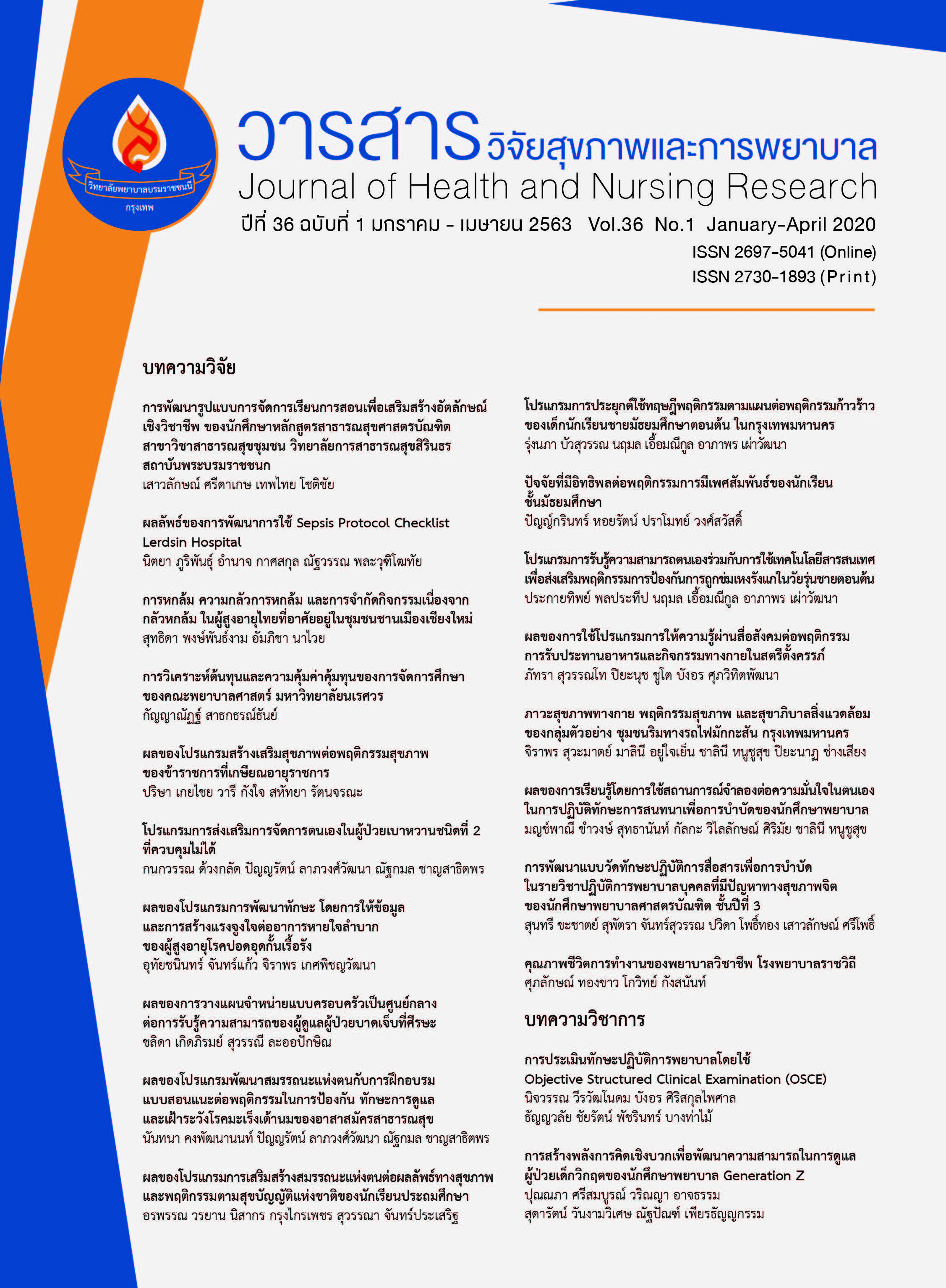ผลของการวางแผนจำหน่ายแบบครอบครัวเป็นศูนย์กลางต่อการรับรู้ความสามารถของผู้ดูแลผู้ป่วยบาดเจ็บที่ศีรษะ
คำสำคัญ:
การวางแผนจำหน่าย, ครอบครัวเป็นศูนย์กลาง, การรับรู้ความสามารถของผู้ดูแลผู้ป่วยบาดเจ็บที่ศีรษะบทคัดย่อ
การวิจัยนี้เป็นการวิจัยกึ่งทดลอง มีวัตถุประสงค์เพื่อเปรียบเทียบ 1) การรับรู้ความสามารถของผู้ดูแลผู้ป่วยบาดเจ็บที่ศีรษะก่อนและหลังได้รับการวางแผนจำหน่ายแบบครอบครัวเป็นศูนย์กลางและ 2) การรับรู้ความสามารถของผู้ดูแลผู้ป่วยบาดเจ็บที่ศีรษะหลังได้รับการวางแผนจำหน่ายแบบครอบครัวเป็นศูนย์กลางและการวางแผนจำหน่ายแบบปกติ โดยนำแนวคิดครอบครัวเป็นศูนย์กลางของ Glavin, และคณะและการรับรู้ความสามารถของตนเองของ Bandura มาประยุกต์ใช้ในกระบวนการวางแผนจำหน่ายผู้ป่วย กลุ่มตัวอย่าง คือ ผู้ดูแลผู้ป่วยบาดเจ็บที่ศีรษะที่เข้ารับการรักษาในโรงพยาบาลรามาธิบดี จำนวน 58 คน แบ่งเป็นกลุ่มทดลองและกลุ่มควบคุม กลุ่มละ 29 คน คัดเลือกโดยใช้วิธีเจาะจง เครื่องมือที่ใช้ในการวิจัย ได้แก่ คู่มือการวางแผนจำหน่ายแบบครอบครัวเป็นศูนย์กลาง และแบบสอบถามการรับรู้ความสามารถของผู้ดูแลผู้ป่วยบาดเจ็บที่ศีรษะ เครื่องมือทั้งหมดได้รับการตรวจสอบความตรงเชิงเนื้อหาจากผู้ทรงคุณวุฒิ 3 ท่าน คู่มือการวางแผนจำหน่ายแบบครอบครัวเป็นศูนย์กลางมีค่าดัชนีความตรงตามเนื้อหา (CVI) เท่ากับ 0.88 แบบสอบถามการรับรู้ความสามารถของผู้ดูแลผู้ป่วยบาดเจ็บที่ศีรษะมีค่าความเที่ยงเท่ากับ 0.90 วิเคราะห์ข้อมูลด้วยค่าเฉลี่ย ส่วนเบี่ยงเบนมาตรฐาน และ สถิติทดสอบที
ผลการวิจัยพบว่า
- การรับรู้ความสามารถของผู้ดูแลผู้ป่วยบาดเจ็บที่ศีรษะภายหลังได้รับการวางแผนจำหน่ายแบบครอบครัวเป็นศูนย์กลางสูงกว่าก่อนได้รับการวางแผนจำหน่ายแบบครอบครัวเป็นศูนย์กลาง อย่างมีนัยสำคัญทางสถิติ (p<.05)
- การรับรู้ความสามารถของผู้ดูแลผู้ป่วยบาดเจ็บที่ศีรษะภายหลังได้รับการวางแผนจำหน่ายแบบครอบครัวเป็นศูนย์กลางสูงกว่ากลุ่มที่ได้รับการวางแผนจำหน่ายตามปกติอย่างมีนัยสำคัญทางสถิติ (p< .05)
Downloads
เอกสารอ้างอิง
2. World Health Organization. Global status report on road safety 2013: supporting a decade of action. Switzerland: World Health Organization. 2013. [on line]. [Cite in July 22, 2017]. Available from key_facts_on_road_safety_situation_in_thailand_2012-2013_tha.pdf. (in Thai).
3. Department of Non-Communicable Disease Control Ministry of Public Health: Road Accident Situation 2014. [on line]. [Cite in December 8, 2014]. Available from http://wwwThailandncd.com/document/file/info/injured/สถานการณ์อุบัติเหตุปี56.pdf. (in Thai).
4. Poonsuk J. The development of discharge planning model for patients with head injury. Journal of Nurses’ Association of Thailand. North-Eastern Division 2013;31(3):186-94. (in Thai).
5 Glavin E.,et al. Challenging the precepts of family-centered care: Testing a philosophy. Pediatric Nursing 2000; 26 (Issue6).
6 Brewer E, McPherson M, Magrab P, Hutchins V. Family-centered care for children with special health care needs Pediatr Nurse 1989;83:1055-60.
7. Patchalee M. Effects of Family Centered - Care on Family's and Patient's Satisfaction and Family's Confidence in Accidental Patients Care. [doctoral’s thesis]. Chonburi: Burapha University; 2002. (in Thai).
8. Coco K, Tossavainen K, Jaaskelainen JE, Turunen H. Support for traumatic brain injury patients' family members in neurosurgical nursing: a systematic review. Journal of The American Association of Neuroscience Nurses 2011;3(6):337-48.
9. Bandura A. Self-efficacy: The exercise of control. New York: W.H. Freeman and company; 1997.
10. Faul F, Erdfelder E, Buchner A, Lang AG. Statistical power analyses using G*Power 3.1: Test for correlation and regression analyses. Behavior Research Methods 2009;41(4):1149-60. Download PDF. Available from link. Springer.com/article/10.3758/BRM.41.4.1149
11. Phupaiboon. R. Family nursing: concepts theory and implementation. 3rd edition. Bangkok: VJ Printing; 1998. (in Thai).
12. Calvete E, deArroyabe EL. Depression and grief in Spanish family caregivers of people with traumatic brain injury: the roles of social support and coping. Brain Injury 2012;26(6):834−43.
13. Ahmann & Johnson. Family-centered care: facing the new millennium. Interview by Elizabeth Ahmann. Pediatr Nurse 2000;26(1):87-90. Available from https://www.ncbi.nlm.nih.gov/pubmed/12026323.
14. Nitchatima S, Tassanee R, Sunee L, Porntip M. The Effects of A Self-Efficacy Promotion Program for Family Caregivers of Persons with Stroke at Home. Journal of Boromarajonani College of Nursing, Bangkok 2010;26(1):28-43. (in Thai).
15. Sopit S, Renu P, Sermsri S, Srisamorn P. Effects of self-efficacy promotion on perceived self-efficacy of caregivers participating in care provided to critically ill children. Ramathibodi Nursing Journal 2011;17(1):63-74. (in Thai).
16. Bandura A. Social foundation of thought and action: a Social cognitive theory. Newjersy: Prentice-Hall Inc; 1986.
17. Soranee A. Effects of using nursing service program emphasizing family participation on re-admission of children with pneumonia, caring behavior of family caregivers, and satisfaction with nursing service. Journal of Nursing Science 2008;20(1):81-95. (in Thai).
ดาวน์โหลด
เผยแพร่แล้ว
รูปแบบการอ้างอิง
ฉบับ
ประเภทบทความ
สัญญาอนุญาต
บทความที่ได้รับการตีพิมพ์ เป็นลิขสิทธิ์ของวารสารวิจัยสุขภาพและการพยาบาล (วิทยาลัยพยาบาลบรมราชชนนี กรุงเทพ) ไม่สามารถนำไปตีพิมพ์ซ้ำในวารสารฉบับอื่น


















